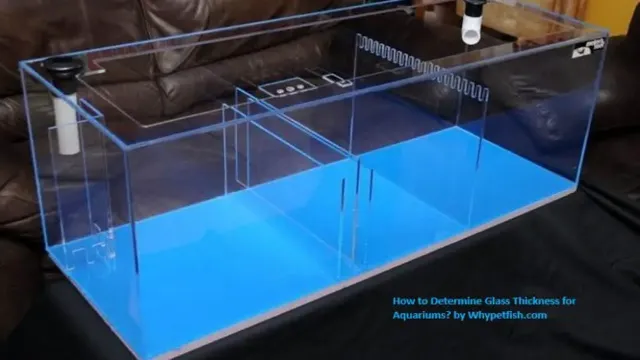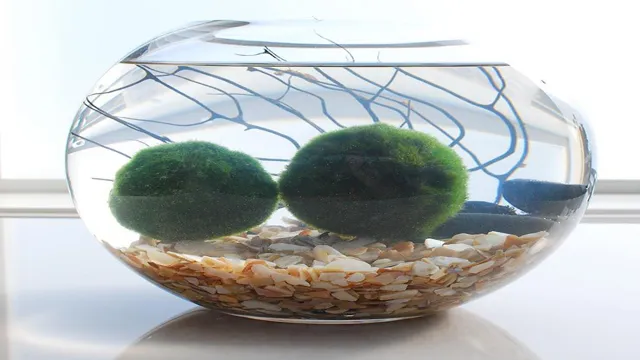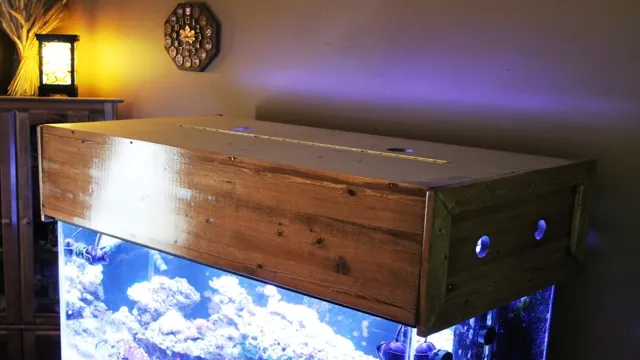If you are a fish lover, there is nothing more exhilarating than watching your aquatic pets swim gracefully in their tanks. But have you ever thought about the impact that the thickness of your aquarium glass can have on your fish’s safety and wellbeing? The truth is, aquarium glass comes in a variety of thicknesses, and choosing the right one is crucial for maintaining a healthy environment for your aquatic pets. In this aquarium glass thickness guide, we will dive into the importance of choosing the correct glass thickness and outline the factors you need to consider to make the best decision for your aquarium.
So, grab a cup of coffee and let’s explore the depths of aquarium glass!
Factors that Affect Glass Thickness
If you’re thinking of setting up an aquarium, one of the most crucial things to consider is the thickness of the glass. The thickness that you’ll need will depend on various factors. Firstly, the size of the aquarium is a significant determinant of the glass thickness.
A larger aquarium with a greater water capacity will require thicker glass to withstand the pressure of the water it holds. Additionally, the type of water that you’ll use in the aquarium can also affect the thickness of the glass. For instance, saltwater is denser than freshwater, and denser water can exert more pressure on the glass.
Other factors that can influence the thickness of the glass include the shape of the aquarium, the location of the aquarium, and the type of fish and decorations you’ll have in the aquarium. Generally, the thicker the glass, the stronger and more durable your aquarium will be. It’s always advisable to consult an expert to have the right glass thickness to ensure your aquarium is safe, sturdy, and long-lasting.
Water Depth and Pressure
One of the critical factors that affect the thickness of glass is the depth of water in which it will be placed. The deeper the water, the higher the pressure that the glass must withstand. Therefore, the thicker the glass has to be.
For instance, if you are building an aquarium or a deep-sea vessel, you must use thicker glass to withstand the pressure that comes with the depth of water. Another factor that affects glass thickness is the size of the glass panel. Larger glass panels require thicker glass to ensure stability, strength, and durability.
When choosing the thickness of glass, it is essential to consider the various factors that affect the glass’s strength and ability to withstand pressure. The choice of glass thickness will depend on the intended application and the environmental conditions it will be exposed to. Therefore, it is critical to seek the services of a professional to get the right recommendations for your intended use.

Aquarium Size and Volume
When it comes to selecting an aquarium for your fish, you have to determine the size and volume that you need. However, another important factor to consider is the type of glass that the aquarium is made from. Thicker glass may be required for larger aquariums, but there are other factors that can affect the necessary thickness.
One crucial factor is the water pressure. The amount of water in the tank can cause pressure on the glass, so if the aquarium is higher or wider, thicker glass will be necessary. Additionally, the type of fish you plan on keeping can also play a role.
Larger or more active fish can bump into the glass and cause stress, which means you’ll need a thicker glass to protect them. All in all, choosing an aquarium size and volume that is right for your fish is important, but you must also consider the type of glass you select for the safety and well-being of your aquatic friends.
Type of Fish and Decorations
When it comes to selecting the right thickness of glass for your fish tank, there are several factors to consider. One of the most important of those factors is the type of fish that you plan on keeping. Some fish are more active and prone to slamming into the walls of the tank, while others are more gentle and don’t require as thick of glass.
Additionally, the decorations you plan on adding to your aquarium can also play a role in determining the necessary glass thickness. For instance, if you want to add large, heavy decorations like rocks or driftwood, you’ll need to ensure that your glass is thick enough to support the weight. Ultimately, it’s important to do your research and consult with professionals when selecting the right thickness of glass for your particular tank.
By taking the time to carefully consider these factors, you can ensure that your fish live in a safe and comfortable environment. (See Also: How to Make a Tower Aquarium: Step-by-Step Guide for Your Home or Office)
Standard Glass Thickness Recommendations
When it comes to aquariums, the thickness of the glass matters as it directly affects their sturdiness. In general, the thickness of the glass depends on the size of the aquarium. For smaller tanks under 40 gallons, 1/4 inch thick glass is considered suitable.
For larger aquariums, thicker glass is recommended. For tanks that are 40 to 60 gallons, 3/8 of an inch thick glass is ideal. For tanks that are larger than 60 gallons, 1/2 inch thick glass is the minimum thickness necessary to ensure durability.
It’s important to keep in mind that this is just a general guideline and the thickness of the glass may vary based on other factors such as the shape of the aquarium and the type of glass used. Overall, it’s better to err on the side of caution and go for thicker glass to ensure the safety of the aquatic wildlife and the longevity of the tank.
Up to 20 gallons: 3/16 inch
When it comes to setting up an aquarium, the type and thickness of glass used is extremely important. A standard recommendation for tanks up to 20 gallons is using a 3/16 inch thickness. This ensures the glass can withstand the weight of the water and any aquarium decor placed inside the tank.
Thicker glass may be necessary for larger aquariums to prevent cracking or breaking. It’s crucial to follow glass thickness recommendations to ensure the safety of both your fish and your home. After all, the last thing anyone wants is a leak or shattered tank.
By following standard guidelines, you can have peace of mind and enjoy the view of your underwater world without any worries.
Up to 40 gallons: 1/4 inch
When setting up an aquarium, choosing the right glass thickness is important for the safety and comfort of your aquatic pets. For tanks up to 40 gallons in size, it is recommended to use a standard glass thickness of 1/4 inch. This thickness provides sufficient strength to hold the weight of the water and prevent any potential cracking or breaking.
Of course, it is important to also consider the quality of the glass, as well as the design and installation of the tank. By choosing a reputable dealer and following proper installation procedures, you can ensure the long-term safety and enjoyment of your underwater environment. So, whether you’re a seasoned aquarium owner or a first-time fish parent, be sure to take the time to research and choose the right glass thickness for your tank, and keep your aquatic friends safe and happy.
Up to 55 gallons: 3/8 inch
When it comes to choosing the right thickness for your aquarium glass, it’s vital to consider the size of your tank. For tanks up to 55 gallons, standard glass thickness recommendations dictate a depth of 3/8 inch. This thickness is enough to provide adequate support for the water pressure while still being lightweight enough to maintain ease of use.
Going too thick can lead to unnecessary weight and bulk, making it difficult to move or reposition your tank. On the other hand, opting for a thinner glass can lead to cracks or breaks, risking the safety of your aquatic pets. So, it’s crucial to find the right balance between safety and convenience when selecting the glass for your aquarium.
Keep in mind that this standard recommendation may vary based on other factors, such as the shape of your tank and the type of fish or plants you keep.
Up to 75 gallons: 1/2 inch
If you’re setting up an aquarium, choosing the right glass thickness is essential for preventing leaks and damage. For tanks up to 75 gallons, a half-inch thickness should suffice. This thickness also offers enough strength and durability to withstand the weight of the water and any decorations you add. (See Also: How to Add CO2 to Aquarium Without CO2: A Complete Guide for Beginners)
Keep in mind that larger tanks may require thicker glass, so it’s important to do your research before making a purchase. Additionally, always ensure that the glass is of high quality and free from any defects or impurities. Overall, taking the time to select the right glass thickness will help ensure a safe and enjoyable aquarium experience for both you and your aquatic pets.
Up to 120 gallons: 3/4 inch
When it comes to choosing the right glass thickness for your aquarium, it’s important to consider the size of your tank. For tanks up to 120 gallons, a glass thickness of 3/4 inch is standard. This thickness provides adequate support for the weight of the water and the inhabitants of the tank.
However, it’s important to note that other factors, such as the quality of the glass and the design of the tank, can also impact the overall strength and durability of the aquarium. It’s always best to consult with a professional when designing and building your aquarium to ensure that it’s safe for your aquatic pets and long-lasting. At the end of the day, investing in a quality aquarium with appropriate glass thickness can provide years of enjoyment and a safe and healthy home for your fish.
So, whether you’re a seasoned aquarium enthusiast or a beginner, take the time to do your research and ensure that your tank is both beautiful and functional.
Custom Glass Thickness Recommendations
When it comes to aquariums, the thickness of the glass is a crucial factor to consider. The thickness of the glass is primarily determined by the size of the aquarium and the type of fish or other aquatic creatures that will inhabit it. The general rule of thumb is that the larger the aquarium, the thicker the glass should be.
For example, a small aquarium of less than 20 gallons can be made with glass that is 1/4 inch thick, but for larger aquariums, it’s recommended to use glass that is up to 1 inch thick. This is because the thicker glass will provide more stability and support, preventing any potential cracks or breaks. Additionally, if the aquarium is going to house larger, more aggressive fish, thicker glass will be required to prevent it from shattering under the stress of their movement.
Ultimately, it’s best to consult with a professional aquarium installer or manufacturer to determine the appropriate thickness for your individual needs.
Consult with a Professional
When it comes to custom glass thickness, it’s essential to consult with a professional. There are various factors to consider when determining the appropriate thickness for your specific project, such as the size of the glass, the weight it needs to support, and the environment in which it will be installed. Consulting with a professional can ensure that your glass is not only aesthetically pleasing but also safe and functional.
They can recommend the best type of glass for your project and provide insight into the required thickness to meet safety standards. Don’t leave this important decision up to guesswork – reach out to a professional today for their custom glass thickness recommendations.
Consider Additional Reinforcement
When it comes to custom glass thickness recommendations, it is important to consider additional reinforcement. While thicker glass may seem like the obvious choice for increased strength and durability, it may not always be enough to withstand potential impacts and pressure. Adding reinforcement such as laminated glass or tempered glass can significantly improve the overall strength of your custom glass project.
Laminated glass is made by bonding layers of glass with a plastic interlayer, while tempered glass undergoes a heating and cooling process that increases its strength and makes it more shatter-resistant. These options are especially important for high-traffic areas or places where safety is a concern. By opting for additional reinforcement, you can ensure that your custom glass project is not only visually stunning but also safe and sturdy.
Final Tips for Choosing Aquarium Glass Thickness
When it comes to aquariums, the thickness of the glass is a crucial factor in ensuring the safety and longevity of your aquatic pets. As a general rule of thumb, the thickness of the glass should be proportional to the size of your tank. For smaller aquariums (less than 20 gallons), a thickness of 1/4 inch should suffice.
Medium-sized tanks (between 20-50 gallons) may require a thicker glass of around 3/8 inch, while larger tanks (above 50 gallons) may need a glass thickness of 1/2 inch or more. Of course, factors such as the type of glass used and the overall design of your tank can also influence the needed thickness of glass. When in doubt, consult with a professional to determine the best thickness for your aquarium to ensure the safety of your aquatic pets. (See Also: How to Adjust pH in an Aquarium: Tips and Tricks for Optimal Water Conditions)
Conclusion
After diving deep into the world of aquariums, it’s clear that the thickness of aquarium glass depends on a variety of factors, including the size of the tank, the type of water and creatures being housed, and even the location of the aquarium. But one thing’s for sure – when it comes to aquariums, it’s always better to be safe than sorry. So don’t be afraid to err on the side of caution and invest in thicker glass.
Trust us, your fish will thank you for it.”
FAQs
What factors determine the necessary thickness of aquarium glass?
The necessary thickness of aquarium glass is determined by the water pressure, the size of the aquarium, and the type of glass being used.
How can I calculate the required glass thickness for my aquarium?
You can use online calculators or consult with a professional to determine the required glass thickness for your specific aquarium.
Can I use tempered or laminated glass for my aquarium?
Yes, tempered or laminated glass can be used for aquariums, but it’s important to ensure that the glass meets the necessary thickness requirements.
What are the disadvantages of using thinner glass for my aquarium?
Thinner glass can be more prone to cracking or breaking under the pressure of the water, which can be dangerous for the fish and the aquarium itself.
How often should I check for cracks or weaknesses in my aquarium glass?
It’s important to inspect your aquarium glass regularly, at least once a month, to check for any cracks, scratches, or other weaknesses that could potentially lead to a leak or a break.
Are there any safety precautions I should take when handling aquarium glass?
Yes, it’s recommended to wear gloves and safety glasses when handling aquarium glass, especially if you’re cutting or drilling the glass.
What should I do if I notice a crack or weakness in my aquarium glass?
If you notice a crack or weakness in your aquarium glass, it’s important to take immediate action. This may include draining the aquarium, repairing or replacing the glass, or seeking professional help.






